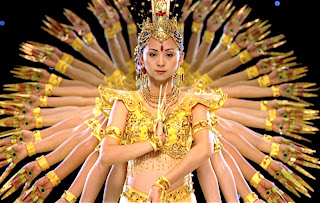DVD Review - Samsara
 |
| 1000 Hands Dance in Beijing |
The selling point for this film is that it was actually photographed by Friske on 70mm film. He did so carefully over the course of five years, ending in 2010 or 2011. He visited about 25 countries and tons of locations, capturing some of the most gorgeous locations and some of the most interesting human feats that most Americans have never seen.
Given Friske's meticulousness, his technique and his choice of camera subject ensures that his film will look pretty. Yet, his is nothing more spectacular than other nature documentary, even the most recent Disney film Earth (2009). What makes Friske's film stand out is the Asian culture and how he attempts to convey or even compare it to American culture. What also makes it stand out is the lack of narration and words at all, so the comparisons or messages is all in the visual edits or cuts.
The film could be considered a long, zen meditation or it's a film that would be perfect to play in a Best Buy or Target as the movie to showcase a HDTV or Blu Ray machine. For the most part, Friske is admiring images and certain cultures. Because those images are jaw-dropping, the movie works, but there is no story. There's no context.
For example, Friske opens the film showing three, child Legong dancers in Indonesia. They're clearly Asian, colorful and elaborately-dressed. They move like bobblehead dolls or something, and there is no explanation as to why. Why are we looking at them? By the end, Friske has depicted several types of dancers. He depicts the Ladyboys of Cascade Bar in Thailand, the CPDRC Dancing Inmates in the Philippines, as well as the 1000 Hands Dance in Beijing.
Yet, Friske never tells you who these people are. You would have to Google them afterwards. By the end, they might be interesting to watch, but I didn't see the point or why he chose these specific dancers. An argument could be made that all these dancers often dance not because they choose to do so but because their situations demanded it, but you don't get that from the film. That's something to infer from reading the various Wikipedia pages of these dancers.
If Friske's goal was to portray the Tibetan idea of birth, existence, death and reincarnation, he does so in non-subtle ways. For birth, he shows babies, babies being baptized in Brazil to babies being held by their tribal mothers in Ethiopia or by their tattooed fathers in the United States. For existence, he shows people going about their lives in fast-motion, time-lapse photography. We see people whizzing by on foot through streets or by car through highways. We bounce from water park to a gym to a ski slope. Aside from the superfluous stuff, we also see people doing the things to support life in the modern era. Friske takes us into a poultry farm in Denmark, a dairy farm in California, a food processing facility in China and appliance manufacturing in the Orient, according to Joe Fassler of The Atlantic. For death, and possibly reincarnation, Friske shows things like the Kane Kwei Coffin Shop in Ghana, Africa, as well as the Pyramids of Giza in Egypt, which were essentially humongous tombs in the City of the Dead.
It's not just people and human cultures. Friske also applies this idea of birth, existence, death and reincarnation to nature, not animals. Friske doesn't photograph creatures in the wild, only people. The rest of the time his lens focuses on landscapes. For birth, he captures the violent reactions that possibly gave rise to the rocky panoramas that Friske favors with his early depiction of the Kilauea Volcano in Hawaii. For existence, Friske merely uses time-lapse photography to depict light and shadow passing over desert vistas in Namibia, Turkey or Jordan. He shows the passage or the evolution of the Earth through things like the Epupa Falls in Angola. For death and reincarnation, Friske shows the rise of artificial constructs, even beautiful ones like the Burj Khalifa or the Palm Island Development in the United Arab Emirates, to not so beautiful ones like the Payatas Trash Dump in Manila or the Ninth Ward in New Orleans. The Payatas is the only true scene that could be interpreted as an ugly location. Its pollution or pollution in general isn't underlined, but only I'm inferring that nature's death is implied in that scene.
The scenes aren't edited together as I've laid them out, so the flow in that kind of narrative sense doesn't work. It's something you'd have to infer. The idea of Samsara is rather lost here, or it's something that isn't made linear or clear. The movie is basically a travelogue where Friske seems particularly fascinated with the art and architecture in the eastern half of the world.
Friske seems to attempt to make a point about religion, one without judgement. He also attempts to make a point about body image. It starts with the Legong dancers and the way these little girls have on makeup and all this ornate covering their faces and bodies. It continues with the Ladyboys of Cascade Bar and their transsexual nature. It ends with a shot of a man prepping for plastic surgery and then cut to a Japanese doll factory and a series of plastic faces and bodies. In the middle, Friske includes a show from Olivier de Sagazan who is a performer in Paris, France. He throws paint or clay in a grotesque and almost violent fashion. It's disturbing and shocking.
Three Stars out of Five.
Rated PG-13 for some disturbing and sexual images.
Running Time: 1 hr. and 42 mins.










amazing picture, awesome dance
ReplyDeletethank you :)